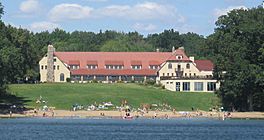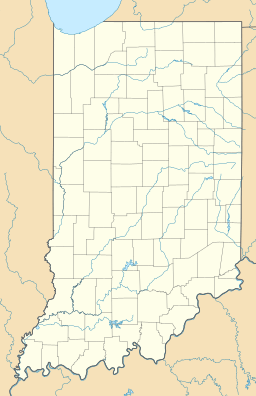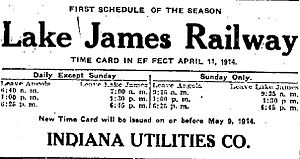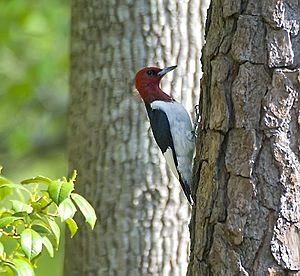Lake James (Indiana) facts for kids
Quick facts for kids Lake James |
|
|---|---|

Pokagon State Park's Potawatomi Inn on the First Basin of Lake James
|
|
| Location | Steuben County, Indiana |
| Coordinates | 41°42′00″N 85°02′20″W / 41.70000°N 85.03889°W |
| Type | mesotrophic glacial lake |
| Primary inflows | 3 creeks (largest is Croxton Ditch) plus minor tributaries |
| Primary outflows | Jimmerson Creek, located between Lake James and Jimmerson Lake |
| Catchment area | 4,322 acres (1,749 ha) |
| Basin countries | United States |
| Max. length | 2 mi (3.2 km) |
| Max. width | 1 mi (1.6 km) |
| Surface area | 1,228.56 acres (497.18 ha) |
| Average depth | 27 ft (8.2 m) |
| Max. depth | 88 ft (27 m) |
| Water volume | 33,171.22 acre⋅ft (40,916,100 m3) |
| Residence time | 312 days |
| Shore length1 | 17.5 mi (28.2 km) |
| Surface elevation | 965 ft (294 m) |
| Islands | Kemery Island |
| 1 Shore length is not a well-defined measure. | |
Lake James is a large natural lake in the northeast part of Indiana, United States. It's a popular spot for boating and fishing, and it's home to many different kinds of plants and animals. Lake James is the fourth-largest natural lake in Indiana, covering over 1,200 acres (490 ha) of water. It's made up of three main parts, called basins. The water quality here is considered one of the best among Indiana's lakes.
Lake James is the biggest lake in a group known as the James Lake Chain. Most of these lakes are in Steuben County, Indiana, but some stretch into southern Michigan. Hundreds of years ago, in the 1700s, this area was a huge swamp. It was a hunting ground for the Potawatomi Native American people.
Pokagon State Park is a big park located along all three parts of Lake James. It's named after two important Potawatomi leaders: Simon Pokagon and his father Leopold. The park is over 1,200 acres (490 ha) in size and is open all year. You can go camping, hike on trails, ride a toboggan in winter, and enjoy two beaches. The park's Potawatomi Inn hotel sits on the north side of the lake's lower basin.
Lake James was named by a surveyor named James Watson Riley. People started settling around the lake after it was first mapped in 1831. At first, it was hard to get to the lake because there were no good roads. But then, a small railroad was built from the city of Angola to the lake. This made it much easier for visitors to come. Today, almost all of the lake's shoreline has homes and cottages, except for Pokagon State Park and one private campground. Two other large lakes, Jimmerson Lake and Snow Lake, are connected to Lake James. Water from these lakes flows west and eventually reaches Lake Michigan.
Contents
Exploring Lake James: Basins and Islands
Lake James is a glacial lake, meaning it was formed by glaciers thousands of years ago. It's located in the northeast corner of Indiana, in Steuben County. This county is right next to Michigan and Ohio. The city of Angola is about 3 miles (5 km) southeast of the lake.
Lake James has three main sections: the First, Second, and Third Basins. The First Basin is the furthest south, and the Third Basin is the furthest north. Snow Lake is just north of the Third Basin. Even though Snow Lake is now separate, it used to be considered part of Lake James. Over time, plants grew and separated it from Lake James. There's also a small community called Lake James on the western side of the lake.
As Indiana's fourth-largest natural lake, Lake James is big enough for a state park and many boat ramps. It covers about 1,229 acres (497 ha) and has about 17.5 miles (28.2 kilometres) of shoreline. The lake's average depth is 27 feet (8.2 m), but its deepest spot is 88 feet (27 m). All three basins have underwater islands, and one island in the First Basin is still above the water.
Islands of Lake James
The island in the First Basin is about 200 feet (61 metres) from the shore on the south side of the lake. In the early 1900s, it was called Kemery Island. It has one cottage, a pier, and several trees.
Lake James also has two other smaller "islands." One tiny island is near Bledsoe's Beach on the west side of the Second Basin. Locals unofficially call it Goat Island. It wasn't always an island, but erosion created a channel around it. Starting in 1969, goats were brought to the island each summer to eat the plants and keep it tidy. This practice stopped in the 1970s, but the name "Goat Island" stuck.
The Third Basin has a neighborhood called Eagle Island. This "tidal island" is connected to the mainland by wetlands and marshes. About 10 cottages on the island can be reached by a special road called a causeway.
History of Lake James
Most of the native Potawatomi people left the region around 1830. Lake James and the surrounding area were first mapped in 1831. The lake was named by a surveyor named James Riley. It's not clear if it was Captain James Riley or his son, James Watson Riley, but the name likely honors one of them.
First People and Pokagon State Park
The oldest known people to live in Indiana were the Woodland Indians. These "mound builders" lived in the area from about 1,000 BC to 900 AD. They disappeared, and new tribes like the Miami and Potawatomi Indians arrived in the 1700s. The Lake James area was a hunting ground for the Potawatomi, who used controlled fires to manage the land and wildlife.
After a treaty in 1830, most Potawatomi moved west. However, the Pokagon Band of Potawatomi Indians, led by Leopold Pokagon, made an agreement to stay in southern Michigan. Pokagon State Park, which is on Lake James, is named after Chief Leopold Pokagon and his son Simon. The park is 1,260 acres (510 ha) and touches all three basins of Lake James, as well as Snow Lake. The park has two beaches for swimming on Lake James. One is in front of the Potawatomi Inn, and the other is on the southeastern shore of the Third Basin.
Early Settlement and the Railway
People started settling around Lake James after the surveys in the 1830s. But growth was slow because there weren't many roads. By 1870, the nearby community of Jamestown only had 779 people. In 1875, Lake James was known for its clear water and good fishing.
Cottages began to appear on Lake James in the late 1800s. Development sped up when an electric railway connected the city of Angola to the southern tip of the lake's First Basin, an area called Paltytown.
The Lake James Electric Railway started passenger service on July 14, 1904. It usually ran from April to November, closing in the winter. The railway also built a dance hall, a hotel, and an amusement park at Paltytown. Many early cottage owners would take the train to Angola, then the electric railway to Paltytown, and finally a boat to their cottage.
The railway was not very profitable and stopped running regularly on October 15, 1918. It was taken apart in 1919. Better roads and cars made the railway unnecessary, but it was very important for the lake's early development. In 1928, the former resort at Paltytown became the Lake James Christian Assembly.
Mail Delivery by Boat
In 1927, the United States Postal Service started delivering mail to lakefront homes on Lake James by boat! This service ran all summer, six days a week. By the 1950s, Lake James was thought to be the only place in the U.S. with "cottage-to-cottage delivery by speedboat" on an inland freshwater lake. About 200 homes received mail, packages, and newspapers right at their piers. You could even buy stamps from the boat!
Bledsoe's Beach: A Popular Spot

Bledsoe's Beach, located near where Lake James connects with Jimmerson Lake, became a popular place for fun in the 1900s. It eventually had a dance hall, a lounge, a hotel, a swimming area, and even a golf course. From the 1960s, it was also the summer home of the Hoosier Basketball Camp. Advertisements in the 1930s and 40s promoted dancing every Saturday night, and later, almost every night! In the early 1960s, it was called "the Midwest's Favorite Fun Spot" with live music and DJs. The property was sold in 2011, and a new restaurant with lake views opened there in 2013.
Lake James Environment
Lake James and other nearby lakes were formed by glaciers about 10,000 years ago, at the end of the Ice Age. Large pieces of glaciers broke off and got buried in the land as the main glaciers moved north. When these ice pieces melted, they filled the low areas, creating many lakes and marshes.
Lake James has a "catchment area" of 4,322 acres (1,749 ha). This is the area of land where all the rain and snow eventually drain into the lake. The main streams flowing into Lake James are Croxton Ditch, Sowles Bay inlet, and Whisper Bay inlet. Croxton Ditch is the largest. Water from the First and Third Basins flows into the Second Basin. From there, it leaves the lake through a short stream called Jimmerson Creek, which flows into Jimmerson Lake. The water in Lake James completely replaces itself about every 312 days.
The James Lake Chain
Lake James is part of the James Lake Chain, a group of glacial lakes in northeast Indiana and part of Michigan. Lake James is the biggest lake in this group and the fourth largest natural lake in Indiana. The entire area that drains into this chain of lakes is 26,290 acres (10,640 ha). This region stretches from Kinderhook, Michigan, in the north to just north of Angola, Indiana, in the south. Most of it is in Steuben County, Indiana. Water from the James Lake Chain flows westward through Lake James into Jimmerson Lake. From Jimmerson Lake, the water continues west, eventually joining the St. Joseph River, which flows into Lake Michigan.
Water Quality and Health
The U.S. Environmental Protection Agency (EPA) studied Lake James in 1973 and called it a mesotrophic lake. This means it has a medium amount of nutrients. The water temperature in early August ranged from 46.4 to 78.4 °F (8.0 to 25.8 °C). The lake's pH was usually between 7.3 and 8.5.
Dissolved oxygen is very important for fish and other water creatures to breathe. Most fish need 3 to 5 milligrams per liter of oxygen. In Lake James, the dissolved oxygen levels averaged 4.6 milligrams per liter in early August.
Nutrients like phosphorus and nitrogen are good for plants, but too much can lead to less oxygen in the water. The EPA found that Lake James had moderate levels of these nutrients. Another way to check water quality is with a Secchi disk. This disk is lowered into the water until it can no longer be seen. The deeper it can be seen, the clearer the water. The Secchi depth in Lake James averaged 2.7 metres (8.9 ft) in August, meaning the water was quite clear. Overall, Lake James ranked as the 3rd best in water quality out of 27 Indiana lakes tested by the EPA that year.
More studies in 2005 confirmed that Lake James is a mesotrophic lake. Before 2006, a new wastewater plant was built, connecting almost all homes around Lake James to off-site waste treatment. This helps reduce the amount of nutrients entering the lake, which is good for its future water quality.
Climate Around Lake James
The weather data for Angola, Indiana, which is about 3 miles (5 km) from Lake James, gives us an idea of the local climate. Angola typically has about 7.5 days a year where the temperature reaches 90 °F (32 °C) or higher. It also usually has about 13.3 days where the temperature drops to 0 °F (−18 °C) or lower. The hottest temperature ever recorded was 106 °F (41 °C) in 1936, and the coldest was −27 °F (−33 °C) in 1981.
| Climate data for Angola, Indiana (3 miles from Lake James) | |||||||||||||
|---|---|---|---|---|---|---|---|---|---|---|---|---|---|
| Month | Jan | Feb | Mar | Apr | May | Jun | Jul | Aug | Sep | Oct | Nov | Dec | Year |
| Mean daily maximum °F (°C) | 30 (−1) |
34 (1) |
45 (7) |
58 (14) |
69 (21) |
78 (26) |
82 (28) |
80 (27) |
73 (23) |
61 (16) |
48 (9) |
34 (1) |
58 (14) |
| Mean daily minimum °F (°C) | 15 (−9) |
17 (−8) |
25 (−4) |
36 (2) |
47 (8) |
57 (14) |
61 (16) |
59 (15) |
50 (10) |
39 (4) |
30 (−1) |
20 (−7) |
38 (3) |
| Average precipitation inches (mm) | 2.28 (58) |
2.21 (56) |
2.61 (66) |
3.37 (86) |
4.37 (111) |
3.88 (99) |
4.00 (102) |
4.14 (105) |
3.37 (86) |
2.95 (75) |
3.15 (80) |
2.74 (70) |
39.07 (994) |
| Source: The Weather Channel | |||||||||||||
Lakes in northern Indiana freeze during the winter, usually from mid-November to mid-March. In a study from the 1940s, Lake James was covered in ice from December 15, 1947, to March 21, 1948. The ice was as thick as 16 inches (41 cm) that winter.
Plants and Animals of Lake James
Lake James is home to many different plants and animals because it has woodlands and wetlands right next to its waters. Pokagon State Park, which was first called Lake James State Park, is located by the lake.
Animals Around the Lake
The park's forests mostly have sugar and red maple trees. You can find a variety of animals in the park and surrounding area. Some of these include Blanding's turtles, northern leopard frogs, and star-nosed moles. You might also see beavers, coyotes, and foxes. White-tailed deer and raccoons are also common.
Many different birds live around Lake James. Common birds like ducks, geese, gulls, and purple martins are seen when the lake isn't frozen. Migrating birds such as loons, grebes, and cormorants can be spotted, especially in the fall. Hawks and red-headed woodpeckers live here all year, as do barred and great horned owls. Several bald eagles were seen on the lake in 2006. Other birds you might observe, especially near Pokagon State Park, include brown creepers, veeries, different types of warblers, bluebirds, Carolina wrens, Baltimore orioles, and pileated woodpeckers.
Fish and Plants in the Lake
Fishing is popular at Lake James all year round. Surveys show that the lake has about 20 different kinds of fish. The most common fish is the bluegill, followed by largemouth bass and rock bass. You can also find yellow bullheads, yellow perch, redear sunfish, and Northern pike.
Lake James also has over 20 types of aquatic plants. Most of these plants are found at depths between 4.5 feet (1.4 metres) and 12 feet (3.7 metres). At shallower depths, a plant-like algae called chara is common. In slightly deeper water, you'll find Illinois pondweed, Vallisneria, and Sago pondweed. Variable watermilfoil grows in depths from 7 feet (2.1 metres) to 15 feet (4.6 metres). Beyond 15 feet (4.6 metres), chara is usually the only plant, and it has been found growing as deep as 36.5 feet (11.1 metres). Most of the plants in the lake are native species, which means they naturally belong there and provide food and shelter for fish and waterfowl.
Fun and Recreation at Lake James
Besides being home to Pokagon State Park and the Lake James Christian Assembly, Lake James is famous for boating and fishing. A sandbar in the First Basin, close to the Potawatomi Inn, is a popular spot where many boats gather. In a 2005 survey, over 60 percent of lake residents said their favorite activities were fishing, fast boating, and water skiing.
Boating has become so popular that some residents worry about too many boats on summer weekends. In August 2005, there were about 2,000 boats docked on the lake! Ski boats, cabin cruisers, deck boats, and fishing boats made up 36 percent of these. Pontoon boats were 22 percent, and personal water crafts (like jet skis) were another 17 percent. The rest were sailboats, canoes, kayaks, and row boats.
Almost all of the lake's shoreline, except for Pokagon State Park, has been developed with homes and cottages. Many families have owned property on the lake for over 20 years. You can find lakefront homes for sale in many styles and prices, including some valued over $1 million. Residents and visitors can also join weekly sailboat races organized by the Lake James Yacht Club.
The lake also hosts special events. The 4th of July is celebrated with a boat parade and fireworks. Every September, the Seaplane Pilots Association holds a Seaplane Splash-In in the lower basin, near the Potawatomi Inn.








